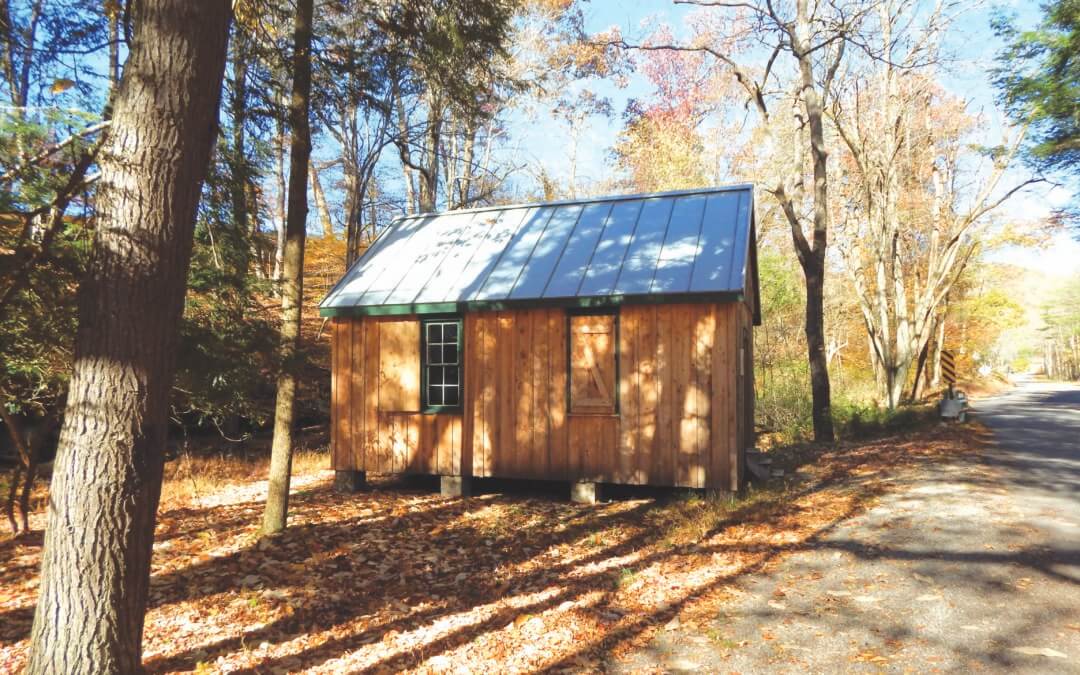By Ken Dzaack, Maintenance Program Supervisor, Deep Creek Lake State Park
(Originally Published by The Maryland Historical Trust; reprinted with permission)
The community of Sang Run, Maryland is a close-knit gathering of neighbors located along the banks of Ginseng Run in west central Garrett County. For more than 100 years, the Friends Store, and the Sang Run Election House were at the heart of this small community. The Election House, thought to date to 1872, was the polling place for Sang Run and the surrounding area until 1972. It is the oldest polling place of its type in the county. The property remained in the Friend family for more than 150 years before being gifted to the State of Maryland, eventually becoming Sang Run State Park.
At the time of its transfer to state ownership in 2007, the balloon-frame structure was in fair condition, though it exhibited some weather and vandalism damage. Park records show that serious discussion about preservation work on the Election House began in February of 2011, followed by Maryland Historical Trust approval of a stabilization project proposal in February of 2012. However, in the meantime, the structure began to deteriorate. Significant funding and manpower from Deep Creek Lake State Park and community volunteers succeeded in keeping the structure from failing. In 2015, temporary frame stabilization was installed. With the creation of Sang Run State Park in 2017, stabilization and preservation of the Election House took on a higher priority.
In 2018, Department of Natural Resources (DNR) Engineering and Construction staff, the Maryland Park Service Critical Maintenance Chief Wayne Suydam, the Deep Creek Lake State Park’s Manager Roy Musselwhite and Maintenance Program Supervisor Ken Dzaack assessed the Election House in preparation for work to begin in 2019. Using information gathered during the assessment, and the few existing historic photographs, DNR Engineering and Construction was able to develop a plan to return the election house to its original circa-1872 appearance, whereby the Maryland Park Service dedicated the resources needed to have the project completed by park service staff. The core construction team included the original assessment team plus maintenance supervisors and lead technicians Derek McFarland, Brian Buckel and Duane Stein from Rocky Gap, New Germany and Herrington Manor State Parks.
Perhaps one of the most challenging aspects of the project was locating supplies of “period-appropriate” materials. All the original framing and siding lumber was native species, rough cut, and weathered. After exhausting an extensive list of potential used-lumber sources, the team elected to contact an Amish-owned sawmill to supply 2 x 12 x 12 hemlock siding, batten boards, and framing lumber. Other local milling firms supplied original pattern trim and an original pattern entry door using the required lumber species. In another building on the property, a supply of period accurate 4-over-4 windows, with intact period glass, was located. The rural setting of this location, and the geographic area, played a large part in being able to get accurate materials in a cost effective and timely manner.
Physical work began on the building on June 7, 2019, with removal and salvaging of all reusable material. Because of the tight time table set for the bulk of the work on this project, the Park Service’s Western Region Maryland Conservation Corp crew was called on to participate. After salvaging the usable material, new piers were set and new beams and a subfloor were put in place. The walls were framed, taking care to restore the original window configuration, and the construction of the heavy hemlock roof trusses began. The trusses were lifted and set by hand 10 feet over the floor. The roof was sheathed with 1 X 12 lumber in keeping with the original construction methods and eventually restored with a period-accurate, custom-made standing seam metal roof.
Because there was not enough original lumber salvaged to cover the entire building, it was decided to use the original siding on the most visible sides of the building and new Hemlock siding on the remainder. As was done in the original construction, the siding was installed vertically. Handling this rough-cut material by hand gave the entire crew a new appreciation for what it took to construct this building over 140 years ago.
Finally, the replacement windows were stripped and completely rebuilt at the Rocky Gap State Park shop. The glass and old finish was removed. Damaged wood was removed and new pieces installed. The original glass was cleaned, replaced, pointed, and glazed. New, original design exterior shutters also were built at Rocky Gap. In time, the crew addressed interior surfaces, including new red oak hardwood flooring, as well as period-appropriate trim. On April 23, 2020, the project was considered 100% complete. The core construction crew individuals received a Maryland Park Service Superintendent’s Commendation Award. This read, in part: “Your efforts have distinguished yourself and the Maryland Park Service as we advance the long-term preservation of this significant historical landmark.”
The Sang Run Election House’s historic significance to the area could be best characterized by an anecdote from a bygone election: While counting ballots some officials wanted to declare a winner, another official halted the declaration by reminding them that the votes from Sang Run had not arrived yet. Evidently, the voting power of the area was substantial! Resident feeling for the Sang Run Election House was emphasized during the project by the constant arrival of folks who talked about their memories of the building, expressing their appreciation of its being preserved. Several people remembered casting their first ballot in the building. Many others remember, as children, going on Election Day so their parents could vote.
The completed Sang Run Election House at Sang Run State Park will be used for interpretive programs and special events. Come see us!

